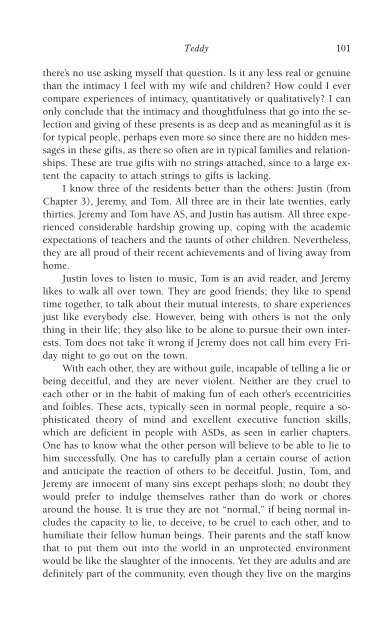978-1572305441
autism
autism
Create successful ePaper yourself
Turn your PDF publications into a flip-book with our unique Google optimized e-Paper software.
Teddy 101<br />
there’s no use asking myself that question. Is it any less real or genuine<br />
than the intimacy I feel with my wife and children? How could I ever<br />
compare experiences of intimacy, quantitatively or qualitatively? I can<br />
only conclude that the intimacy and thoughtfulness that go into the selection<br />
and giving of these presents is as deep and as meaningful as it is<br />
for typical people, perhaps even more so since there are no hidden messages<br />
in these gifts, as there so often are in typical families and relationships.<br />
These are true gifts with no strings attached, since to a large extent<br />
the capacity to attach strings to gifts is lacking.<br />
I know three of the residents better than the others: Justin (from<br />
Chapter 3), Jeremy, and Tom. All three are in their late twenties, early<br />
thirties. Jeremy and Tom have AS, and Justin has autism. All three experienced<br />
considerable hardship growing up, coping with the academic<br />
expectations of teachers and the taunts of other children. Nevertheless,<br />
they are all proud of their recent achievements and of living away from<br />
home.<br />
Justin loves to listen to music, Tom is an avid reader, and Jeremy<br />
likes to walk all over town. They are good friends; they like to spend<br />
time together, to talk about their mutual interests, to share experiences<br />
just like everybody else. However, being with others is not the only<br />
thing in their life; they also like to be alone to pursue their own interests.<br />
Tom does not take it wrong if Jeremy does not call him every Friday<br />
night to go out on the town.<br />
With each other, they are without guile, incapable of telling a lie or<br />
being deceitful, and they are never violent. Neither are they cruel to<br />
each other or in the habit of making fun of each other’s eccentricities<br />
and foibles. These acts, typically seen in normal people, require a sophisticated<br />
theory of mind and excellent executive function skills,<br />
which are deficient in people with ASDs, as seen in earlier chapters.<br />
One has to know what the other person will believe to be able to lie to<br />
him successfully. One has to carefully plan a certain course of action<br />
and anticipate the reaction of others to be deceitful. Justin, Tom, and<br />
Jeremy are innocent of many sins except perhaps sloth; no doubt they<br />
would prefer to indulge themselves rather than do work or chores<br />
around the house. It is true they are not “normal,” if being normal includes<br />
the capacity to lie, to deceive, to be cruel to each other, and to<br />
humiliate their fellow human beings. Their parents and the staff know<br />
that to put them out into the world in an unprotected environment<br />
would be like the slaughter of the innocents. Yet they are adults and are<br />
definitely part of the community, even though they live on the margins



